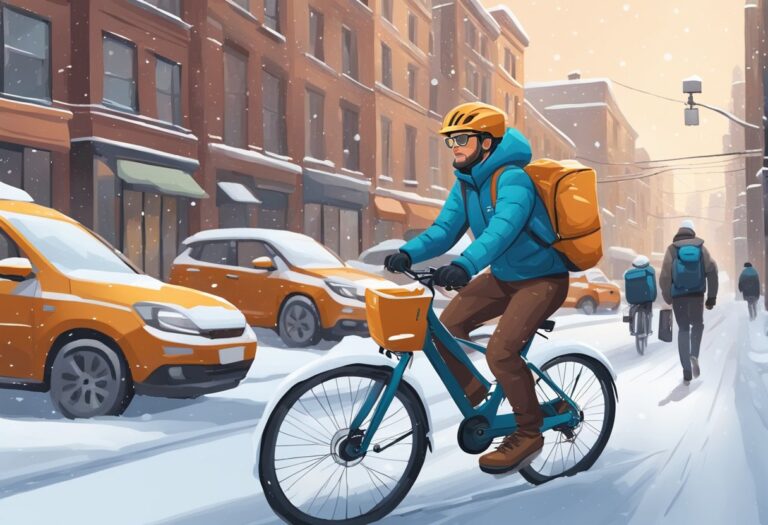Choosing the Right Winter Gear for E-Bike Commuting
Commuting by electric bike in winter requires careful preparation to ensure both safety and comfort.
The colder months bring unique challenges for e-bike riders, not least being the impact of low temperatures on the bike’s battery performance and the rider’s own resilience against the elements.
Riders must consider temperature-related power efficiency and traction issues while choosing their gear.
Proper attire and accessories are vital for winter e-bike commutes. Insulated clothing protects against the cold, while a reliable lighting system is crucial for visibility during shorter daylight hours.
Equipping the e-bike with winter-ready tires improves grip on slippery surfaces. A robust winter cycling routine incorporates measures for maintaining both the e-bike’s battery and the rider’s body temperature to optimize performance and safety.
Additionally, addressing the demands of winter e-bike maintenance can extend the vehicle’s longevity and reliability. Preparing an electric bike for winter commuting involves understanding how different components react to cold conditions.
From specialized lubricants to guard against the seizure of mechanical parts, to mudguards that keep slush at bay, the selection of the right winter gear can transform the riding experience.
Table of Contents
Understanding E-Bike Winterization
Battery Care for Cold Temperatures
E-bike batteries are less efficient in cold weather, requiring special attention to maintain performance. Keep batteries fully charged and store them in a warm environment before use.
Charge and store the battery at room temperature whenever possible to preserve its longevity and sustain reliable lighting systems.
Importance of Tires in Winter E-Biking
Tires significantly influence an e-bike’s handling in winter conditions. Riding with winter-ready tires that have appropriate tread patterns and rubber compounds designed for cold temperatures improves safety and stability.
Maintaining Traction on Icy Roads
For the e-biker facing icy roads, the choices in tires extend to studded tires or fat tires for enhanced grip. Adjusting tire pressure lower than usual can also increase the tire’s contact with the road, thereby improving traction.
E-Bike Cleaning and Maintenance
Regular maintenance is crucial for e-bike longevity, especially during winter.
Clean and lubricate the chain and gears frequently to prevent rust and damage from road salt and debris.
Check all components before each ride to ensure they function correctly for a safe commuting experience.
Rider Safety and Comfort
Choosing the Right Winter Attire
Thermal clothing is essential for maintaining core body temperature during cold weather rides. Riders should start with a moisture-wicking base layer to keep sweat away from the skin.
Adding an insulating mid-layer, such as fleece or wool, provides warmth.
The topmost layer should be windproof and water-resistant to protect against the elements. It’s crucial to dress in layers to be able to adjust to changing temperatures.
- Footwear: Waterproof boots with thermal or wool thermal socks.
- Gloves: Insulated and water-resistant gloves for warmth and dexterity.
- Helmet: With a full-coverage design and lined with thermal material for added insulation.
- Balaclava or neck gaiter: For face and neck coverage, protect against wind chill.
Safety Measures for Winter Riding
Implementing safety measures is key to risk-free winter riding. A crucial aspect is maintaining control, which is achieved through appropriate tire pressure and using winter-ready electric bike tires for better traction.
Mechanical systems, including brakes, need regular checks, as response times can be slower in cold conditions.
- Braking: Adjust riding to brake cautiously on slick surfaces.
- Battery care: Keep the battery warm and insulated, and store it indoors to preserve charge capacity.
Visibility and Lighting in Reduced Daylight
Reduced daylight requires heightened visibility measures. A reliable lighting system comprising both front and rear lights helps riders see and be seen in low-light conditions.
Additionally, wearing reflective clothing or adding reflective elements to the bike greatly increases visibility to other road users.
- Bike lights: Always use lights, and ensure they’re fully charged or carry spares.
- Reflective elements: These can be on a helmet, jacket, or bike frame.
Enhancing E-Bike Winter Performance
When commuting via electric bike in winter conditions, maintaining optimal performance requires special attention to the battery, tires, and brakes. These adjustments are critical for safety and efficiency in cold weather, particularly on icy roads and slippery surfaces.
Optimizing Battery Life and Range
To maximize battery life and range during winter e-biking, keep the battery warm using a battery cover and avoid charging it in extremely cold temperatures.
Batteries tend to lose capacity in cold weather, which can reduce the overall range of your e-bike.
- Battery Care Tips:
- Warm before charging: Never charge a battery when it is extremely cold.
- Insulate: Use a battery cover to shield it from the cold.
- Storage: Store the e-bike and battery in a warmer environment if possible.
Tire Pressure Adjustments for Slippery Surfaces
The pressure in tires drastically affects traction on icy roads and slippery surfaces. Lowering tire pressure can increase the tire’s contact area with the ground, enhancing grip.
For more severe conditions, studded tires may be required for additional traction.
- Tire Pressure for Conditions:
- Icy or Snowy Surfaces: Lower tire pressure slightly.
- Extremely Slippery Conditions: Consider studded tires.
Brakes and Handling on Slick Surfaces
Braking power and handling are affected by winter conditions. It is crucial to give yourself more braking distance and be gentle with brake application on slick surfaces. Regularly check your brakes for optimal performance and response.
- Braking Tips:
- Increase distance: Allow for greater stopping distance on icy roads.
- Maintenance: Regularly check brake pads and mechanisms for reliability.
Practical Tips for Winter E-Bike Commuting
Winter e-bike commuting can be a safe and enjoyable experience with the correct preparation. Ensuring the e-bike’s components are in good working order and utilizing weather-protective gear and accessories are pivotal to thriving in adverse conditions.
Routinely Checking Bike Components
- Battery Care: Cold temperatures can affect the performance and lifespan of your e-bike’s battery. Store the battery in a warm place when not riding, and consider insulation like a neoprene cover during rides.
- Tire Pressure: Adjust tire pressure for better traction on hard-packed or slippery surfaces. Lower pressure increases grip, but too low can cause flats.
- Brakes and Gears: Check these more frequently in winter months due to increased likelihood of road grit and grime affecting their performance.
- Lights: Ensure your lights are working properly for visibility during the shorter, often darker days of winter.
Weather-Protective Gear and Accessories
- Fenders and Mudguards: Install fenders and mudguards to protect against splashes from wet roads.
- Cleaning Routine: Regularly clean your e-bike to remove salt and dirt build-up that can lead to corrosion.
- Panniers: Use weather-resistant panniers for carrying items to protect them from snow and rain.
- Apparel: Dress in layers appropriate for the temperature, including wind and waterproof outer garments.
- Lock: Keep a de-icer handy for your lock to prevent freezing.
Each tip aims to address various aspects of e-bike commuting in winter, including handling the cold impact on the e-bike’s battery, maintaining the right tire pressure for snowy conditions, keeping components clean, and choosing the appropriate gear to counteract the harsh weather.
Navigating Winter Terrains on an E-Bike
When the winter season sets in, e-bike enthusiasts face the challenge of commuting through a transformed landscape that often resembles a winter wonderland. Careful route planning and weather considerations become crucial for safe and enjoyable riding experience.
Identifying Safe Routes and Pathways
One must prioritize identifying safe and clear routes that are less likely to be obstructed by snow and ice.
Electric bikes offer the advantage of handling road conditions with ease, provided the rider selects the right pathways. Essential attributes of winter-safe routes include:
- Clearance: Regularly plowed and treated to prevent ice buildup.
- Visibility: Well-lit areas that help in recognizing possible hazards like black ice, especially on bridges which often freeze before roadways.
- Bike Paths: Exclusive bike paths offer a secure alternative, as they are typically less crowded and away from vehicular traffic.
Mapping out preferred routes before departure is always a sensible approach.
Handling Extreme Weather Conditions
The handling of extreme weather conditions hinges on the rider’s preparedness and the capability of their electric bike. It is important to address the following elements:
- Precipitation: Wet conditions demand waterproof gear and careful navigation to avoid slippery spots.
- Temperature: Heated grips and insulated clothing can help combat the cold.
- E-Bike Care: Keeping the battery warm and maintaining tire pressure are vital for optimal e-bike performance in cold weather.
By equipping oneself with knowledge and appropriate gear, one can enjoy the benefits of e-bike commuting throughout the winter months.
Storing Your E-Bike in Winter
When winter arrives, proper storage of an e-bike is crucial to maintain battery efficiency and ensure longevity.
Cold temperatures can significantly impact battery performance; hence, it’s essential to store the battery in a location where the temperature is stable and above freezing, ideally between 10 and 22°C (50 – 72°F).
Riders should detach the batteries from their e-bikes if the storage area is not insulated or experiences low temperatures.
Insulation plays a key role in protecting the e-bike’s electronic components from cold and moisture.
If the storage space is not naturally insulated and is prone to damp conditions, consider using a breathable cover that will protect it from moisture and dust without trapping condensation, which can lead to corrosion.
Lubrication before storage aids in the prevention of any rust or corrosion on the chain or moving parts. It’s best to clean and lubricate these components as part of your winterization process.
Using lubricants suited for lower temperatures will provide better protection during the winter months.
Here are some vital steps for e-bike winter storage:
- Remove and store the battery at an appropriate temperature
- Clean and lubricate moving parts
- Use a breathable cover for insulation
- Store in a dry and protected environment
Following these guidelines will help preserve the integrity of the e-bike’s mechanical and electrical systems during the winter period.
Conclusion
Winter commuting on an electric bicycle demands attention to detail and proper preparation. Riders should equip themselves with appropriate tires designed for cold and slippery conditions. Winter-specific tires offer superior grip, substantially enhancing safety. For personal comfort and visibility, wearing weatherproof and light-colored clothing is advisable, ensuring riders remain dry and conspicuous on the road.
Key Considerations for Equipment:
- Tires: Specifically designed for winter to prevent slippage.
- Clothing: Must be weatherproof and high-visibility.
Maintaining the e-bike’s battery in optimal condition by storing and charging it at room temperature is also crucial, as cold temperatures can significantly decrease battery performance and reduce charge capacity.
Riders must also anticipate a potential torque delay and adapt their riding technique accordingly to mitigate risks on icy surfaces.
Tips for Battery Care:
- Store at room temperature.
- Charge indoors to prevent performance drop.
By considering these factors, cyclists can enjoy a secure and pleasurable winter riding experience.
The key is to prepare both the e-bike and oneself for the harsher conditions, ensuring that the journey is as smooth and enjoyable as possible, regardless of the colder climate.




Leave a comment